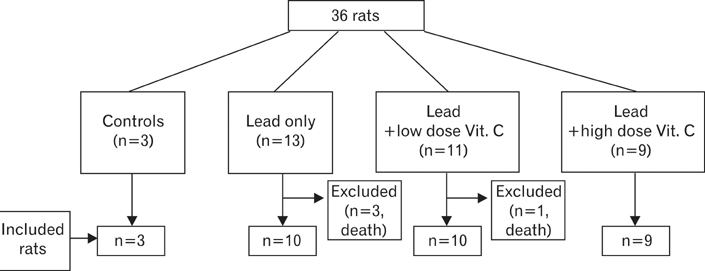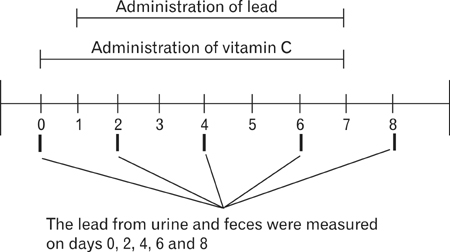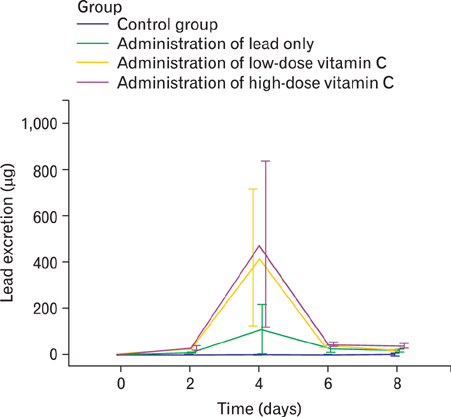Anat Cell Biol.
2013 Dec;46(4):239-245. 10.5115/acb.2013.46.4.239.
Vitamin C modulates lead excretion in rats
- Affiliations
-
- 1Department of Family Medicine, Kosin University College of Medicine, Busan, Korea. fmcjs@naver.com
- 2Department of Anatomy, Kosin University College of Medicine, Busan, Korea.
- 3Department of Pathology, Kosin University College of Medicine, Busan, Korea.
- 4Department of Surgery, Kosin University College of Medicine, Busan, Korea.
- 5Department of Family Medicine, Inje University College of Medicine, Busan, Korea.
- KMID: 2046764
- DOI: http://doi.org/10.5115/acb.2013.46.4.239
Abstract
- Lead, one of the most toxic heavy metals, takes longer time to be excreted from the body than other heavy metals. The purpose of this study is, by measuring lead excretion via urine and feces, to find out the effect of vitamin C in lead chelation. Thirty-six rats were randomly assorted into four groups. All 33 rats except for the control group were administered with lead, before orally administered with different doses of vitamin C per kilogram of body weight. The lead excretion levels in urine and feces as well as the survival rate were then measured for each group. The rats with lead administrations (10/13, 76.9%) with lead administrations only, 10/11 rats (90.9%) with lead administrations and low dose of vitamin C, 9/9 rats (100%) with lead administrations and high dose of vitamin C survived. Among the 29 surviving rats, low vitamin C intake group exhibited higher urinary excretion than the lead only group. The urinary excretion level in high dose vitamin C intakegroup was significantly higher than the lead only group. In addition, fecal lead excretion seemed to be increased in the high dose vitamin C intake group, compared to the group with lead administrations only with statistical significance. Through animal experiment, it was found out that administrating high dose of vitamin C accelerated the excretion of lead in body compared to low dose of vitamin C.
MeSH Terms
Figure
Reference
-
1. Donaldson WE, Knowles SO. Is lead toxicosis a reflection of altered fatty acid composition of membranes? Comp Biochem Physiol C. 1993; 104:377–379.2. deSilva PE. Determination of lead in plasma and studies on its relationship to lead in erythrocytes. Br J Ind Med. 1981; 38:209–217.3. Leggett RW. An age-specific kinetic model of lead metabolism in humans. Environ Health Perspect. 1993; 101:598–616.4. Waldron HA. The anaemia of lead poisoning: a review. Br J Ind Med. 1966; 23:83–100.5. Hernberg S, Nurminen M, Hasan J. Nonrandom shortening of red cell survival times in men exposed to lead. Environ Res. 1967; 1:247–261.6. Levander OA, Morris VC, Ferretti RJ. Filterability of erythrocytes from vitamin E-deficient lead-poisoned rats. J Nutr. 1977; 107:363–372.7. Lidsky TI, Schneider JS. Adverse effects of childhood lead poisoning: the clinical neuropsychological perspective. Environ Res. 2006; 100:284–293.8. Piomelli S, Rosen JF, Chisolm JJ Jr, Graef JW. Management of childhood lead poisoning. J Pediatr. 1984; 105:523–532.9. Varnai VM, Piasek M, Blanusa M, Juresa D, Sarić M, Kostial K. Ascorbic acid supplementation does not improve efficacy of meso-dimercaptosuccinic acid treatment in lead-exposed suckling rats. Pharmacol Toxicol. 2003; 93:180–185.10. Fujimoto Y, Nakatani E, Horinouchi M, Okamoto K, Sakuma S, Fujita T. Inhibition of paraquat accumulation in rabbit kidney cortex slices by ascorbic acid. Res Commun Chem Pathol Pharmacol. 1989; 65:245–248.11. Simon JA, Hudes ES. Relationship of ascorbic acid to blood lead levels. JAMA. 1999; 281:2289–2293.12. Hsu PC, Guo YL. Antioxidant nutrients and lead toxicity. Toxicology. 2002; 180:33–44.13. Gurer H, Ercal N. Can antioxidants be beneficial in the treatment of lead poisoning? Free Radic Biol Med. 2000; 29:927–945.14. Flora SJ, Pande M, Mehta A. Beneficial effect of combined administration of some naturally occurring antioxidants (vitamins) and thiol chelators in the treatment of chronic lead intoxication. Chem Biol Interact. 2003; 145:267–280.15. Patra RC, Swarup D, Dwivedi SK. Antioxidant effects of alpha tocopherol, ascorbic acid and L-methionine on lead induced oxidative stress to the liver, kidney and brain in rats. Toxicology. 2001; 162:81–88.16. Tandon SK, Singh S, Prasad S, Srivastava S, Siddiqui MK. Reversal of lead-induced oxidative stress by chelating agent, antioxidant, or their combination in the rat. Environ Res. 2002; 90:61–66.17. Acharya UR, Rathore RM, Mishra M. Role of vitamin C on lead acetate induced spermatogenesis in swiss mice. Environ Toxicol Pharmacol. 2003; 13:9–14.
- Full Text Links
- Actions
-
Cited
- CITED
-
- Close
- Share
- Similar articles
-
- Effect of Vitamin E on Cadmium Accumulation and Excretion in Chronic Cadmium Poisoned Rats
- Effect of oral D-penicillamine in Urinary excretion of lead
- Regular moderate exercise training can alter the urinary excretion of thiamin and riboflavin
- A Study on the Urinary Lead Excretion after Oral D-penicillamine Administration
- High Dose Vitamin D3 Attenuates the Hypocalciuric Effect of Thiazide in Hypercalciuric Rats





